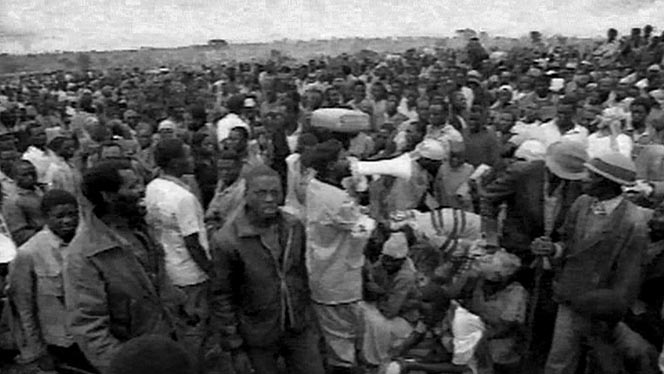Encounters with conflict and peace
Hutu Power re-groups
As hundreds of thousands of Hutus poured into refugee camps in surrounding countries, Hutu Power leaders worked on a strategy to re-conquer Rwanda.
Among the refugees there were around 30,000 soldiers and militia who were fleeing after their role in the genocide killings. With the support of the government of Zaire (Congo) they planned to continue killing Tutsis and to de-stabilise the new government in Rwanda.

Refugee life: extortion, rape and thuggery

The refugees spread over a network of 60 miles of roads, probably the largest group of fugitive murderers ever assembled, all fed and shelterd by the aid agencies while Hutu Power made profits from refugee commerce, monopolising the distribution of international aid, and creating a growing trade in purloined humanitarian provisions. There was even tax collection, the money quickly diverted into arms purchases. Richard McCall, chief of staff of the US Agency for International Development, described the camps as “an unfettered corridor for arms shipment”. Goma settled down into a state within a state, a new “Hutu land” carved out in Zaire…
In November some of the aid agencies threatened to withdraw from the camps, for the people in them were no more than hostages, denied the right to return to their homes, denied equal access to aid and a guarantee of basic human rights. Some agency staff did walk out. MSF-France stated that the diversion of humanitarian aid by the same people who orchestrated the genocide, the lack of effective international action regarding impunity, and the fact that the refugees were held hostage, presented a situation which was contradictory to the principles of humanitarian assistance.
Death and debt
While aid poured into the refugee camps in Zaire, and while Hutu Power re-armed and re-trained, in Kigali there was nothing but debt.. In October 1994 France lobbied against the new regime in all the international institutions, trying to block aid from the European Union, and arguing that money should be paid only when the refugees outside Rwanda returned to their country.
Donor countries insisted that the new government negotiate with the previous leaders and hold open elections. The new government thought this was absurd. There was nothing to negotiate; no-one to negotiate with, apart from mass murderers.
The World Bank had earmarked $140 million for Rwanda but wanted $4.5 million first in arrears; under the rules, new loans are not allowed unless other debts are paid, and the new government owed the World Bank US$6 million in arrears. The new regime would have to repay money borrowed from the international financial institutions, money that had been spent on the genocide. Having provided substantial assistance for the refugees, donors now held back, waiting until the new regime had ‘established its credibility’.
In November 1995, the Egyptian Office of Military Intelligence wrote to the Rwandan government to demand one million dollars, due at the Credit Lyonnais bank in London, part payment for weapons under the arms contract signed in March 1992. The debt was eventually paid.
From A People Betrayed. The role of the west in Rwanda's genocide, by Linda Melvern
< previous page | next page >
In this section
INHERITING A WASTELAND
A wasteland
Refugees and debt
The children
INSIGHT
Survivor questions
Going home
Time and silence
Time is broken
Impossible to forgive
AFTER THE GENOCIDE I CAME TO RWANDA
The aid worker
The young Rwandan
The young exile
The journalist

A wasteland
Refugees and debt
The children
INSIGHT
Survivor questions
Going home
Time and silence
Time is broken
Impossible to forgive
AFTER THE GENOCIDE I CAME TO RWANDA
The aid worker
The young Rwandan
The young exile
The journalist

